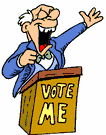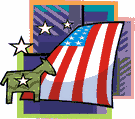How the President Is Elected
Part
1: How It Starts
Most people who run for president are already famous. After all, if you want to be chosen by a majority of the people in America, it helps if many of them know who you are.
Most people who run for president are already serving in government, as members of the U.S. Senate or the House of Representatives or as state governors. Former military officers have also run for president.
A presidential candidate first makes an official announcement that he or she is running for president. Then, he or she or someone else on his or her behalf must file papers with the federal elections commission, which regulates the election process. Candidates usually make these announcements at least a year before the presidential election, in order to give themselves enough time to get their messages out and also to give voters enough time to get to know the candidates.
 Once the announcement is made, the candidate begins to work very hard to make sure that he keeps his or her name in the public eye. He or she makes speeches, meets with officials from other countries, goes on high-profile trips, etc. The candidate also tends to cut back on time he or she spends in government (if he or she is serving there) to run for president.
Once the announcement is made, the candidate begins to work very hard to make sure that he keeps his or her name in the public eye. He or she makes speeches, meets with officials from other countries, goes on high-profile trips, etc. The candidate also tends to cut back on time he or she spends in government (if he or she is serving there) to run for president.
When January of an election year rolls around, the candidates begin their heavy lifting for the campaign ahead. As more months go by, people in the American states gather to show their support for the various candidates. (It is very rare for just one candidate from a major political party to run for president, so many names means many people running for the same job.) These gatherings are called primary elections or caucuses. A primary election looks very much like a general election: Voters get ballots that list the names of the people running for president and then go to a polling place and vote for one of those people. A caucus is a gathering of people who discuss the issues and the candidates at a central location and then cast their votes for candidates.

 It should be noted here that the majority of people who vote in an American presidential election belong to some kind of political party. The two major political parties are Democratic and Republican. Other political parties include Reform, Green, Natural Law, and Libertarian. If you belong to the Democratic Party, you will get a primary election ballot that contains only the names of the people running for president who are also Democrats. The same is true for Republican voters and for members of other political parties. In the general election, anyone can vote for anyone.
It should be noted here that the majority of people who vote in an American presidential election belong to some kind of political party. The two major political parties are Democratic and Republican. Other political parties include Reform, Green, Natural Law, and Libertarian. If you belong to the Democratic Party, you will get a primary election ballot that contains only the names of the people running for president who are also Democrats. The same is true for Republican voters and for members of other political parties. In the general election, anyone can vote for anyone.
Leading up to and during the caucus-primary election period, the various presidential candidates make trips across the country, visiting people everywhere and giving speeches, trying to drum up support. Candidates will often appear alongside other famous people, like sports stars or movie stars, hoping to gain some support by association with these people in the spotlight. The candidates will often get together and have debates, which are usually televised. This is another way for voters to make up their minds on which candidate should get their votes.
The various states have their caucuses or primary elections throughout the late winter and spring and then have a major national gathering called a convention in the summer. Each political party picks a group of people from each state to represent the state at this convention. At the convention, the delegates cast their votes for the candidate who was the top vote-getter in that state in the caucus or primary election. (This is a warm-up for the Electoral College, which comes later.)
Next
page > How
It All Ends Up
> Page 1, 2



 Once the announcement is made, the candidate begins to work very hard to make sure that he keeps his or her name in the public eye. He or she makes speeches, meets with officials from other countries, goes on high-profile trips, etc. The candidate also tends to cut back on time he or she spends in government (if he or she is serving there) to run for president.
Once the announcement is made, the candidate begins to work very hard to make sure that he keeps his or her name in the public eye. He or she makes speeches, meets with officials from other countries, goes on high-profile trips, etc. The candidate also tends to cut back on time he or she spends in government (if he or she is serving there) to run for president.
 It should be noted here that the majority of people who vote in an American presidential election belong to some kind of political party. The two major political parties are Democratic and Republican. Other political parties include Reform, Green, Natural Law, and Libertarian. If you belong to the Democratic Party, you will get a primary election ballot that contains only the names of the people running for president who are also Democrats. The same is true for Republican voters and for members of other political parties. In the general election, anyone can vote for anyone.
It should be noted here that the majority of people who vote in an American presidential election belong to some kind of political party. The two major political parties are Democratic and Republican. Other political parties include Reform, Green, Natural Law, and Libertarian. If you belong to the Democratic Party, you will get a primary election ballot that contains only the names of the people running for president who are also Democrats. The same is true for Republican voters and for members of other political parties. In the general election, anyone can vote for anyone. 
